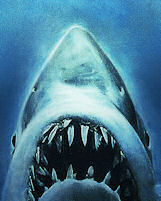What do you think of when you hear the word “Jaws”? You might have some scary or fond memories of watching the many “Jaws” films throughout the years, or you could remember that the original iconic 1975 film was the one that put director Steven Spielberg on the map and ultimately changed the course of Hollywood forever. Whatever your memories, face it – you never think of swimming in the ocean the same way as you did before you saw that movie. Now, “Jaws” (or “Bruce the Shark” as Steven Spielberg and co. coined the physical shark prop) has a new home at the Academy Museum of Motion Pictures in Los Angeles.
The Academy Museum of Motion Pictures completed installation of one of the most iconic objects from its permanent collection, the only surviving full scale shark model from the 1975 Oscar®-winning film “Jaws.” This moment signals exciting momentum toward the Academy Museum’s much-anticipated opening slated for April 30, 2021, where the 25-foot model will be on view, free to the public. “Jaws,” directed by Spielberg, won Oscars® for Film Editing, Sound and Original Score and was nominated for Best Picture at the 48th Academy Awards® in 1976.
“It’s been a long journey for Bruce since he was acquired in 2016, and we couldn’t be happier to welcome him to his new home,” says Bill Kramer, Director and President of the Academy Museum. “We look forward to our opening when museum visitors can engage with our exhibitions, experience our beautiful Renzo Piano-designed building and come face to face with one of the most iconic characters in film history.”
This Bruce shark model is the fourth and only surviving version of the model that was derived from the original Jaws mold. The mechanical Bruce shark has been (in)famously rumored to have been named after Spielberg’s own lawyer. Apropos, perhaps. The creation of the prop fell to art director Joe Alves. His original schematics depict Bruce with a 25-foot long body, a 400-pound head and jaws at a chompingly-convenient five feet wide. The three screen-used molds used during production were cast in rubber and latex, and ultimately rotted and were destroyed.

The Academy Museum’s Bruce was cast in fiberglass and originally used for photo opps at Universal Studios Hollywood in connection with the release of the original “Jaws” in 1975. It lived at Universal Studios until 1990 when it retired to Nathan Adlen’s family junkyard business in Sun Valley, CA.
In 2010, the prop was authenticated by original member of the “Jaws” film’s special effects crew, Roy Arbogast and in 2016, the Academy Museum received he shark model through a contribution by Nathan Adlen. For several years, the museum worked with Greg Nicotero, co-founder of KNB EFX to meticulously restore the fiberglass shark. The special effects and make-up artist had quite the job on his hands, as the shark had deteriorated from being outdoors for a quarter of a century.
The conservation and restoration of the instantly recognizable shark is now complete. But one final hurdle remained. Moving Bruce to his new home at the Academy Museum was a Herculean task. Due to its massive size, the shark would not fit into the museum’s elevators. A team of construction workers, art handlers and engineers removed two sections from the Saban Building’s glass wall and gently and lovingly coaxed Bruce via crane into his new lofty home.
Bruce is now perched 30 feet above the third floor of the Pritzker Prize-winning architect Renzo Piano-designed Academy Museum of Motion Pictures. The general public and old and new generations of fans can now be appreciative and enjoy the prop’s legacy in film-making history once again. In its new location, Bruce will be visible from many vantage points within the museum and to passersby outside on Fairfax Avenue and 6th Street.

Visit www.academymuseum.org for additional information on the Academy Museum of Motion Pictures and its upcoming grand opening.
. . .
Join us on Facebook at
http://www.facebook.com/itsjustmovies!
